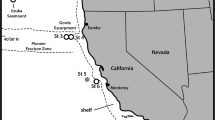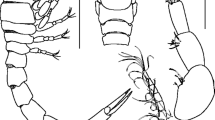Abstract
In this paper, we describe Wataloricus japonicus gen. et sp. nov. (phylum Loricifera), based on specimens collected during surveys of Japanese waters in the Northwest Pacific conducted onboard the TR/Vs TOYOSHIO MARU and SEISUI MARU. This new loriciferan is placed in the family Pliciloricidae based on the morphology of the adult lorica and Higgins larval internal armature, setae, and toes. It is readily distinguished from other pliciloricid genera by the following combination of characters: adult with a long rigid mouth tube bearing an umbrella-like membrane that extrudes from the mouth opening; a double organ consisting of two untransformed separate spinoscalids; 15 single trichoscalids; and approximately 46 longitudinal folds in the lorica and anal field; and Higgins larva with clavoscalids characterized by ventral swelling and spine-like tip; short unsegmented spinoscalids of the second scalid row; indistinct collar, heavily wrinkled thorax; two pairs of anterior setae; two pairs of posterior setae; and slender toes with sub-terminal swelling. The new genus described herein appears to be synonymous with a previously reported undescribed genus sensu Heiner and Neuhaus (2007) from the Galapagos Spreading Centre, thereby indicating that the geographical distribution of the new genus may at least span the entire Pacific region.








Similar content being viewed by others
References
Fujimoto S, Kristensen RM (2020) Loricifera. In: Schmidt-Rhaesa A (ed) Guide to the identification of marine meiofauna. Verlag Dr. Fiedrich Pfeil, München, pp 415–427
Gad (2003) New light on deep-sea Loricifera. Deep-Sea Newsletter 32:4–5
Gad G (2004a) A new genus of Nanaloricidae (Loricifera) from deep-sea sediments of volcanic origin in the Kilinailau Trench north of Papua New Guinea. Helgoland Mar Res 58:40–53. https://doi.org/10.1007/s10152-003-0167-x
Gad G (2004b) The Loricifera fauna of the plateau of the Great Meteor Seamount. Arch Fish Mar Res 51:9–29
Gad G (2005a) Life history stages of Loricifera: their morphology and position in the life cycle. PhD Thesis, Carl von Ossietzky Universität Oldenburg, Germany
Gad G (2005b) Giant Higgins-larvae with paedogenetic reproduction from the deep sea of the Angola Basin – evidence for a new life cycle and for abyssal gigantism in Loricifera? Org Divers Evol 5(Supplement 1):59–75. https://doi.org/10.1016/j.ode.2004.10.005
Gad G (2005c) A parthenogenetic, simplified adult in the life cycle of Pliciloricus pedicularis sp. n. (Loricifera) from the deep sea of the Angola Basin (Atlantic). Org Divers Evol 2005:77–103. https://doi.org/10.1016/j.ode.2004.10.006
Gad G (2005d) Successive reduction of the last instar larva of Loricifera, as evidenced by two new species of Pliciloricus from the Great Meteor Seamount (Atlantic Ocean). Zool Anz 243:239–271. https://doi.org/10.1016/j.jcz.2004.09.001
Gad G (2005e) Hermaphroditism in Loricifera—as evidenced by Rugiloricus doliolius sp. n. from the Antarctic deep sea. In: Thatje S, Calcagno JA, Arntz WE (Eds) Evolution of Antarctic Fauna—Extended Abstracts of the IBMANT/ANDEEP International Symposium and Workshop in 2003. Ber Polarforsch Meeresforsch 507:140–141
Gad G (2009) Culexiregiloricus, a new genus of Nanaloricidae (Loricifera) from the deep sea of the Guinea Basin (Southeast Atlantic). Zootaxa 2096:33–49. https://doi.org/10.11646/zootaxa.2096.1.5
Gad G, Martínez Arbizu P (2005) First report of Arctic Loricifera—a new Rugiloricus-species from the Laptev Sea. Mar Biol Res 1:313–325. https://doi.org/10.1080/17451000500327455
Giere O (2009) Meiobenthology. The microscopic motile fauna of aquatic sediments. Springer, Heidelberg
Harvey THP, Butterfield NJ (2017) Exceptionally preserved Cambrian loriciferans and the early animal invasion of the meiobenthos. Nat Ecol Evol 1:0022. https://doi.org/10.1038/s41559-016-0022
Heiner I (2004) Armorloricus kristenseni (Nanaloricidae, Loricifera), a new species from the Faroe Bank (North Atlantic). Helgoland Mar Res 58:192–205. https://doi.org/10.1007/s10152-004-0185-3
Heiner I (2008) Rugiloricus bacatus sp. nov. (Loricifera –Pliciloricidae) and a ghost-larva with paedogenetic reproduction. Syst Biodivers 6:225–247. https://doi.org/10.1017/S147720000800265X
Heiner Bang-Berthelsen I (2008) Phylogeny of Loricifera based on combined morphological and molecular studies. PhD Thesis, University of Copenhagen
Heiner Bang-Berthelsen I, Schmidt-Rhaesa A, Kristensen RM (2013) Loricifera. In: Schmidt-Rhaesa A (ed) Handbook of zoology. Gastrotricha, Cycloneuralia and Gnathifera. Vol. 1: Nematomorpha, Priapulida, Kinorhyncha, Loricifera. De Gruyter, Berlin, pp 307–328
Heiner I, Kristensen RM (2005) Two new species of the genus Pliciloricus (Loricifera, Nanaloricida, Pliciloricidae) from the Faroe Bank, North Atlantic. Zool Anz 243:121–138
Heiner I, Kristensen RM (2009) Urnaloricus gadi nov. gen. et nov. sp. (Loricifera, Urnaloricidae nov. fam.), an aberrant Loricifera with a viviparous pedogenetic life cycle. J Morphol 270:129–153. https://doi.org/10.1002/jmor.10671
Heiner I, Neuhaus B (2007) Loricifera from the deep sea at the Galápagos Spreading Center, with a description of Spinoloricus turbatio gen. et sp. nov. (Nanaloricidae). Helgoland Mar Res 61:167–182. https://doi.org/10.1007/s10152-007-0064-9
Higgins RP, Kristensen RM (1986) New Loricifera from Southeastern United States coastal waters. Smithson Contrib Zool 438:1–70. https://doi.org/10.5479/si.00810282.438
Kimura T, Kimura S, Jimi N, Kakui K, Tomioka S, Oya Y, Matsumoto Y, Tanabe Y, Hasegawa N, Hookabe N, Homma R, Hosoda Y, Fujimoto S, Kuramochi T, Fujita T, Ogawa A, Kobayashi I, Ishida Y, Tanaka H, Onishi H, Shimetsugu M, Yoshikawa A, Tanaka M, Kushida Y, Maekawa Y, Nakamura T, Okumura J, Tanaka K (2018) Benthic deep-sea fauna in the Sea of Kumano, Mie Prefecture, Japan. Annals of Field Research and Technology Mie University 16:1–32 [in Japanese]
Kristensen RM (1983) Loricifera, a new phylum with Aschelminthes characters from the meiobenthos. Z Zool Syst Evolutionsforsch 21:163–180. https://doi.org/10.1111/j.1439-0469.1983.tb00285.x
Kristensen RM (2017) Palaeontology. Darwin’s dilemma dissolved. Nat Ecol Evol 1:0076. https://doi.org/10.1038/s41559-017-0076
Kristensen RM, Gad G (2004) Armorloricus, a new genus of Loricifera (Nanaloricidae) from Trezen ar Skoden (Roscoff, France). Cah Biol Mar 45:121–156
Kristensen RM, Shirayama Y (1988) Pliciloricus hadalis (Pliciloricidae), a new loriciferan species collected from the Izu-Ogasawara Trench, Western Pacific. Zool Sci 5:875–881
Kristensen RM, Neves RC, Gad G (2013) First report of Loricifera from the Indian Ocean: a new Rugiloricus-species represented by a hermaphrodite. Cah Biol Mar 54:161–171
Kristensen RM, Gooday AJ, Goineau A (2019) Loricifera inhabiting spherical agglutinated structures in the abyssal eastern equatorial Pacific nodule fields. Mar Biodivers 49:2455–2466. https://doi.org/10.1007/s12526-019-00962-y
Neves RC, Kristensen RM (2014) A new type of loriciferan larva (Shira larva) from the deep sea of Shatsky Rise, Pacific Ocean. Org Divers Evol 14:163–171. https://doi.org/10.1007/s13127-013-0160-4
Neves RC, Gambi C, Danovaro R, Kristensen RM (2014) Spinoloricus cinziae (Phylum Loricifera), a new species from a hypersaline anoxic deep basin in the Mediterranean Sea. Syst Biodivers 12:489–502. https://doi.org/10.1080/14772000.2014.943820
Neves RC, Reichert H, Sørensen MV, Kristensen RM (2016) Systematics of phylum Loricifera: identification keys of families, genera and species. Zool Anz 265:141–170. https://doi.org/10.1016/j.jcz.2016.06.002
Neves RC, Kristensen RM, Rohal M, Thisle D, Sørensen MV (2019) First report of Loricifera from the North East Pacific Reigion, with the description of two new species. Mar Biodivers 49:1151–1168. https://doi.org/10.1007/s12526-018-0898-1
Pardos F, Kristensen RM (2013) First record of Loricifera from the Iberian Peninsula, with the description of Rugiloricus manuelae sp. nov., (Loricifera, Pliciloricidae). Helgoland Mar Res 67:623–638. https://doi.org/10.1007/s10152-013-0349-0
Shirayama Y, Kaku T, Higgins RP (1993) Double-sided microscopic observation of meiofauna using an HS-Slide. Benthos Res 44:41–44
Wessel P, Smith WHF, Scharroo R, Luis J, Wobbe F (2013) Generic mapping tools: improved version released. EOS Trans AGU 94:409–410. https://doi.org/10.1002/2013EO450001
Yamasaki H, Fujimoto S, Miyazaki K (2015) Phylogenetic position of Loricifera inferred from nearly complete 18S and 28S rRNA gene sequences. Zool Lett 1:18. https://doi.org/10.1186/s40851-015-0017-0
Acknowledgements
We express our gratitude to the captains and crews of TR/V TOYOSHIO MARU (Hiroshima University; cruise no. 2016-25) and TR/V SEISUI MARU (Mie University; cruise no. 1722), and the research members who participated in these cruises, for their assistance in collecting the sediment samples used in this study. The two anonymous reviewers are acknowledged for their helpful comments that improved this manuscript.
Funding
SF received funding from the Fujiwara Natural History Foundation and RMK received funding from the Carlsberg Foundation grant CF-16-0236.
Author information
Authors and Affiliations
Corresponding author
Ethics declarations
Conflict of interest
The authors declare that they have no conflict of interest.
Ethical approval
No animal testing was performed during this study.
Sampling and field studies
All necessary permits for sampling have been obtained by the authors.
Data availability
All material used in this study is deposited in the Zoological Collection of Kyoto University (KUZ).
Author contribution
SF, TK, and SO collected the material used in this study. SF and RMK observed the material. SF and HY prepared the figures. All authors contributed in preparing the manuscript.
Additional information
Communicated by S. Gollner
Publisher’s note
Springer Nature remains neutral with regard to jurisdictional claims in published maps and institutional affiliations.
This article is registered in ZooBank under http://zoobank.org/6BDAA934-CA6B-40DC-9C7E-B63EC06588C4
Rights and permissions
About this article
Cite this article
Fujimoto, S., Yamasaki, H., Kimura, T. et al. A new genus and species of Loricifera (Nanaloricida: Pliciloricidae) from the deep waters of Japan. Mar. Biodivers. 50, 103 (2020). https://doi.org/10.1007/s12526-020-01130-3
Received:
Revised:
Accepted:
Published:
DOI: https://doi.org/10.1007/s12526-020-01130-3




